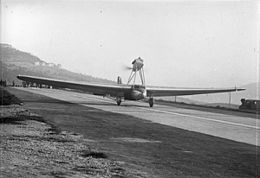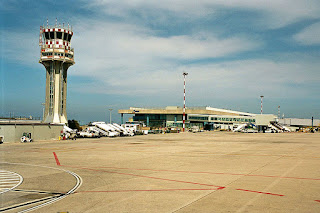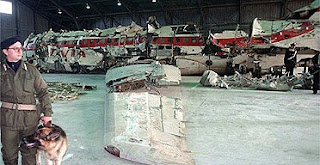Rome-Brazil flight makes history
 |
| The Savoia-Marchetti S64 on the runway at Montecelio airfield, near Rome |
The duo - Carlo Del Prete and Arturo Ferrarin - had taken off from a military airfield at Montecelio near Rome 49 hours and 19 minutes earlier, crossing Northwest Africa and the South Atlantic in their Savoia-Marchetti S64 monoplane on a single tank of fuel.
They were credited with a distance of 7,188km (4,466 miles), that being the great-circle distance (the formula used to calculate the distance between points on the surface of a sphere) between Montecelio and the flight’s intended destination - after several changes of plan - at Natal on the northeastern tip of Brazil.
In fact, after making a series of manoeuvres en route because of weather events, the two had covered around 8,100km (5,033 miles) and, fearing they would run out of fuel before they could reach Natal, took the decision to land on a beach at Touros, some 70km (43 miles) further up the coast.
.jpg) |
| Carlo Del Prete had flown across the Atlantic twice before |
Del Prete, born in Lucca in 1897, was a major in the Regia Aeronautica. He had been chosen as co-pilot by Francesco De Pinedo, one of the Italian pioneers of long-distance flying and a friend from their time in the Italian Navy, for an epic transatlantic journey from Europe to the Two Americas, flying over three continents - Africa, South Africa and North America - and crossing the Atlantic twice, covering a total distance of 43,820 km (27,228 miles).
Ferrarin, who hailed from Thiene in the province of Vicenza, was a former Regia Aeronautica pilot who specialised in aviation contests, acquiring fame through a 1920 race from Rome to Tokyo, stopping in Greece, Syria, India, Burma, Thailand, French Indochina (now Vietnam), China, and Korea, over a distance of 8,000km (4,971 miles). He and fellow Italian Guido Masiero, together with their respective engineers, were the only two finishers from 11 aircraft that began the race.
Together, Del Prete and Ferrarin had set a record earlier in 1928 for the longest distance over a closed circuit, in the same Savoia-Marchetti S.64, completing 51 circuits of a route between Torre Flavia, near Ladispoli, and Anzio along the Tyrrhenian Sea coast, covering 7,666km (4,763 miles) and staying continuously airborne for 58 hours 34 minutes.
The transatlantic flight was planned for the first days of July so that the night hours of the flight would benefit from a full moon. The monoplane, which had been built specifically for long-distance flying, complete with a bunk bed behind one of the seats, took off from Montecelio on a purpose-built runway at 6.51pm on the evening of July 3.
.jpg) |
| Arturo Ferrarin clashed with Fascist politician Italo Balbo |
Weighed down heavily with the fuel necessary for the journey, the plane was able to climb only at 0.25 metres per second. It took 3km (1.8 miles) to reach an altitude of 15m (49ft).
The first difficulty the pilots encountered came as they flew over Africa, when hot winds caused their engine to burn fuel more quickly, prompting them to change their course in order to find cooler temperatures further north.
The next problem was a belt of equatorial thunderstorms, which required them to climb to a safer altitude rather than risk putting the aircraft through stresses of the storm.
The sighting of the Brazilian coastline on the morning of July 5 came as a relief, confirming that that mid-flight route re-calculations had been accurate.
Yet there was more drama ahead with another encounter with bad weather as they headed towards Bahia, this time in the shape of fog, forcing another change of plans. The new destination was now Natal, where they expected to land on the Latécoère airfield . However, worried about their fuel reserve and still hindered by poor visibility, Ferrarin and Del Prete eyed a strip of sand at Touros and decided to put down there.
The landing was not without damage to the plane as its wheels quickly sank into the sand. Nonetheless, the two airmen clambered from the cockpit triumphant. Yet the story had three tragic postscripts.
 |
| The Savoia-Marchetti S64 on the beach at Touros in Brazil after its emergency landing |
On his return to Italy, Ferrarin was awarded the Gold Medal of Aeronautic Valor. However, in 1929 Italo Balbo, a powerful member of Mussolini's Fascist government, who had become the Minister of the Italian Air Force, banned any further participation by Italian airmen in races and competitions on the grounds that they gave prestige to individuals rather than highlighting the power of the regime’s air weaponry. After Ferrarin and Balbo clashed over the decision, Balbo demanded that Ferrarin leave the Air Force.
He joined the aviation division of auto giants Fiat, where his duties included flying company founder Giovanni Agnelli’s seaplane. On one such flight in 1935, with Agnelli’s son, Edoardo, his passenger, he hit an object in the water off Genoa and overturned. He escaped unharmed but Edoardo was killed. Ferrarin himself died five years later in another air accident.
The S64, meanwhile, improved the closed circuit record again in 1930, with pilots Fausto Cecconi and Umberto Maddalena at the controls, flying continuously for a distance of 8,188 km (5,088 miles) and remaining in flight for 67 h 13 min. Sadly, the following year, the S64 crashed into the sea and was never recovered, taking Cecconi and Maddalena and the engineer Giuseppe Da Monte down with it.
Travel tip:
The airfield at Montecelio, with its Fascist-era
architecture, as it was in the 1930s
The Montecelio airfield is now part of a municipality known as Guidonia Montecelio, about 25km (15 miles) northeast of Rome, which comprises the ancient hilltop town of Montecelio, the history of which goes back 6,000 years, and the modern town of Guidonia, built in 1937. Once the home of a fortified Roman fort, Montecelio in the Middle Ages featured a fortress built at the highest point of the town, the remains of which are still visible. A maze of streets and alleyways tumble down the hillside, radiating from a pleasant central square, the Piazza San Giovanni. Guidonia was originally built to house the officers and civilian employees based at the airfield. Built under the guidance of lead architect Alberto Calza Bini, it followed the orthogonal layout of streets typical of other Fascist-era new towns.
Travel tip:.jpg)
Lucca's walls provide a full 4.2km circuit of the city
and are popular with walkers, cyclists and joggers
Lucca, where Carlo Del Prete was born, is situated in western Tuscany, just 30km (19 miles) inland from Viareggio on the coast and barely 20km (12 miles) from Pisa, with its international airport. It is often overlooked by travellers to the area in favour of Pisa’s Leaning Tower and the art treasures of Florence, 80km (50 miles) to the east, yet has much to recommend within its majestic walls, where visitors can stroll along narrow cobbled streets into a number of beautiful squares, with lots of cafes and restaurants for those content to soak up the ambience, but also a wealth of churches, museums and galleries for those seeking a fix of history and culture. The Renaissance walls, still intact, are an attraction in their own right, providing a complete 4.2km (2.6 miles) circuit of the city popular with walkers and cyclists.
Also on this day:
1466: The birth of military leader Giovanni Sforza
1966: The birth of footballer Gianfranco Zola
1974: The birth of motorcycle racer Roberto Locatelli
1982: Paolo Rossi’s World Cup hat-trick
1982: The birth of footballer Albert Gilardino
1984: Diego Maradona signs for Napoli







